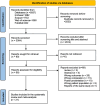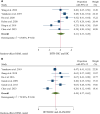A comparison of disseminated intravascular coagulation scoring systems and their performance to predict mortality in sepsis patients: A systematic review and meta-analysis
- PMID: 39821194
- PMCID: PMC11737756
- DOI: 10.1371/journal.pone.0315797
A comparison of disseminated intravascular coagulation scoring systems and their performance to predict mortality in sepsis patients: A systematic review and meta-analysis
Abstract
Background: Disseminated intravascular coagulation (DIC) is a common complication in sepsis patients which exacerbates patient outcomes. The prevalence and outcomes of DIC in sepsis is wide-ranging and highly depends on the severity of the disease and diagnostic approaches utilized. Varied diagnostic criteria of DIC have been developed and their performance in diagnosis and prognosis is not consistent. Therefore, this study aimed to determine the score positivity rate and performance of different DIC scoring systems in predicting mortality in sepsis patients.
Methods: Four databases, including Medline (through PubMed), Scopus, Embase, and Web of Science were searched for studies that determined DIC in sepsis patients using the three scoring systems namely: the International Society on Thrombosis and Hemostasis DIC (ISTH-DIC) criteria, the Japanese association for acute medicine DIC (JAAM-DIC) criteria, and the sepsis-induced coagulopathy (SIC) criteria. A random-effect meta-analysis was performed with a 95% confidence interval (CI). Subgroup analysis was conducted in view of geographic region and sepsis stages. the protocol was submitted to the Prospective Register for Systematic Reviews (PROSPERO) with an identifier (CRD42023409614).
Results: Twenty-one studies, published between 2009 and 2024, comprising 9319 sepsis patients were included. The pooled proportion of cases diagnosed as positive using ISTH-DIC criteria, JAAM-DIC criteria, and SIC were 28% (95% CI: 24-34%), 55% (95% CI:42-70%), and 57% (95% CI: 52-78%), respectively. The pooled mortality rates were 44% (95% CI:33-53%), 37% (95% CI: 29-46%), and 35% (95% CI: 29-41%), respectively. The pooled sensitivity and specificity of ISTH-DIC to predict mortality were 0.43 (95% CI: 0.34-0.52), and 0.81 (95% CI: 0.74-0.87), respectively, while for JAAM-DIC it was 0.73 (95% CI: 0.57-0.85) and 0.46 (95% CI: 0.28-0.65), respectively. Pooled sensitivity and specificity for SIC were 0.71 (95% CI: 0.57-0.82) and 0.49 (95% CI: 0.31-0.66), respectively.
Conclusion: The SIC and JAAM-DIC scores exhibited higher sensitivity to identify patients with coagulopathy and predict patient outcomes, and thus are valuable to identify patients for possible treatment at an early stage. The ISTH-DIC score perhaps identified patients at later stages and demonstrated better specificity to predict disease outcomes. Thus, early identification of patients using the SIC and JAAM-DIC scores and later confirmation using the ISTH-DIC score would be beneficial approach for improved management of patients with sepsis.
Copyright: © 2025 Kiya et al. This is an open access article distributed under the terms of the Creative Commons Attribution License, which permits unrestricted use, distribution, and reproduction in any medium, provided the original author and source are credited.
Conflict of interest statement
The authors have declared that no competing interests exist.
Figures






Similar articles
-
Comparison of Three Different Disseminated Intravascular Coagulation (DIC) Criteria and Diagnostic and Prognostic Value of Antithrombin Investigation in Patients with Confirmed Sepsis-Induced Coagulopathy (SIC).Clin Appl Thromb Hemost. 2024 Jan-Dec;30:10760296241271334. doi: 10.1177/10760296241271334. Clin Appl Thromb Hemost. 2024. PMID: 39196070 Free PMC article.
-
Prognostic Accuracy of the Different Scoring Systems for Assessing Coagulopathy in Sepsis: A Retrospective Study.Clin Appl Thromb Hemost. 2023 Jan-Dec;29:10760296231207630. doi: 10.1177/10760296231207630. Clin Appl Thromb Hemost. 2023. PMID: 37920943 Free PMC article.
-
Prospective comparison of new Japanese Association for Acute Medicine (JAAM) DIC and International Society of Thrombosis and Hemostasis (ISTH) DIC score in critically ill septic patients.Thromb Res. 2012 Apr;129(4):e119-25. doi: 10.1016/j.thromres.2011.11.017. Epub 2011 Dec 3. Thromb Res. 2012. PMID: 22138415
-
Diagnostic and prognostic value of Sepsis-Induced coagulopathy and International Society on Thrombosis and Hemostasis scoring systems in COVID-19-associated disseminated intravascular coagulopathy.J Res Med Sci. 2021 Oct 18;26:102. doi: 10.4103/jrms.JRMS_1295_20. eCollection 2021. J Res Med Sci. 2021. PMID: 34899940 Free PMC article. Review.
-
Diagnosis of sepsis-induced disseminated intravascular coagulation and coagulopathy.Acute Med Surg. 2019 Apr 1;6(3):223-232. doi: 10.1002/ams2.411. eCollection 2019 Jul. Acute Med Surg. 2019. PMID: 31304023 Free PMC article. Review.
References
-
- Taylor J, Toh CH, Hoots WK, Wada H, Levi M. Towards definition, clinical and laboratory criteria, and a scoring system for disseminated intravascular coagulation: On behalf of the scientific subcommittee on Disseminated Intravascular Coagulation (DIC) of the International Society on Thrombosis and. Thromb Haemost 2001;86:1327–30. doi: 10.1055/s-0037-1616068 - DOI - PubMed
-
- Ko BS, Cho HY, Ryoo SM, Kim MC, Jung W, Park SH, et al.. The Prevalence and Significance of Overt Disseminated Intravascular Coagulation in Patients with Septic Shock in the Emergency Department According to the Third International Consensus Definition. Korean J Crit Care Med 2016;31:334–41. doi: 10.4266/KJCCM.2016.00339 - DOI
-
- Kelm DJ, Valerio-Rojas JC, Cabello-Garza J, Gajic O, Cartin-Ceba R. Predictors of Disseminated Intravascular Coagulation in Patients with Septic Shock. ISRN Crit Care 2013;2013:1–6. doi: 10.5402/2013/219048 - DOI
Publication types
MeSH terms
LinkOut - more resources
Full Text Sources
Medical

